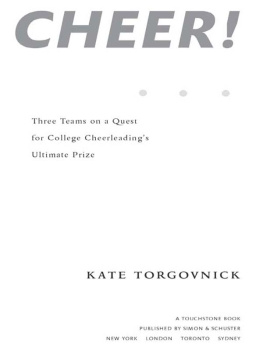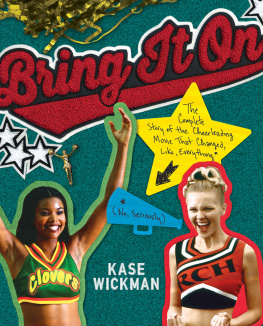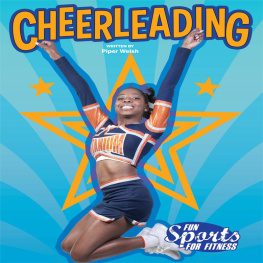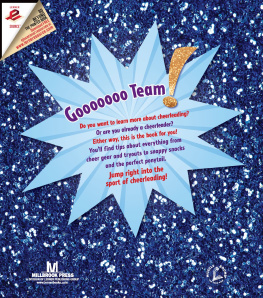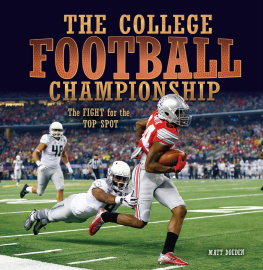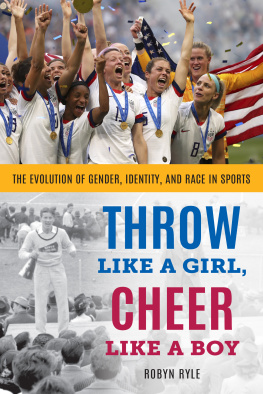
Copyright 2008 by Kate Torgovnick
All rights reserved, including the right to reproduce this book or portions thereof in any form whatsoever. For information address Touchstone Subsidiary Rights Department, 1230 Avenue of the Americas, New York, NY 10020.
TOUCHSTONE and colophon are registered trademarks of Simon & Schuster, Inc.
Library of Congress Cataloging-in-Publication Data
Torgovnick, Kate.
Cheer!: three teams on a quest for college cheerleadings ultimate prize / Kate Torgovnick.
p. cm.(A touchstone book)
1. CheerleadingUnited States. I. Title.
LB3635.T67 2008
791.6'4dc22 2007039277
ISBN-13: 978-1-4165-6600-7
ISBN-10: 1-4165-6600-7
Visit us on the World Wide Web:
http://www.SimonandSchuster.com
Photos on images 1-19 in Phototgraphic Insert Section by Beth Fandal.
Photos on images 20-30 in Phototgraphic Insert Section by Gary Bogdon.
For Lizz, Mom, and Dad, my personal cheerleaders
CONTENTS
AUTHORS NOTE
I WASNT ALWAYS FASCINATED by cheerleaders. I grew up in Durham, North Carolina, and in the halls of Jordan High School, Id see cheerleaders wearing their sky blue skirtsthey always seemed to travel in packs and to be laughing about something. I wondered how they never felt discouraged by the fact that the Falcons they so avidly cheered for never won a football game the entire time we were in school.
I was on the opposite end of the high school clich spectrum. I was the rebel with bright blue streaks in her hair who could usually be found reporting stories for the high school newspaper. In that way that people stand for things when theyre teens, I thought of myself as an individual, while they stood for conformity. They dutifully cheered on the sidelines of every football game while, truth be told, the only time I ever went to a game was when my friend streaked across the field during halftime. I was one of the occupants of his getaway car.
Pep rallies were held several times a year in the gym, and attendance was mandatory. Still, I skipped every single rally, sneaking across the street to a park. I remember walking back onto campus one day after a rally to meet my ride. As I strolled through the parking lot, there was a lot of commotionand an ambulance with its lights flashing. What happened? I asked a friend. A cheerleader fell real bad, he said, not at all concerned. Maybe they should wear helmets.
Others descriptions werent as detached. As another friend told me, Courtney, a senior cheerleader with platinum blonde hair, had fallen off the top of a pyramid onto the hardwood floor. The image she described still sticks in my mindCourtneys head bleeding, the deep red staining her pale yellow hair. A few days later she was back at school, having gotten away with just a concussion.
While I thought of myself as diametrically opposed to the cheerleaders, I recognized their magic. I remember seeing the cheerleaders practicing through the Plexiglas panels of the gym doors. They could all do back handsprings, while Id practically flunked out of gymnastics class. And of course, there were some cheerleaders I couldnt help but likeAmanda, with her square jaw and baby-doll eyes, the editor-in-chief of my school newspaper who ended harsh edits with a smiley face. And Melissa, with a smattering of freckles across her nose, who whispered jokes in English class and who seemed sincerely annoyed when she was chosen Best Looking for senior superlatives.
When I shipped off to Barnard College in New York Citya part of Columbia University, which is not exactly famous for its athleticsI didnt think cheerleaders would be a fact of life anymore. But lo and behold, a Columbia cheerleader lived next door to me in my dorm sophomore year. I laughed when Evelyn, with her olive skin and exotic features, asked if I wanted to go to a game. Still, there was something admirable about how much enthusiasm she could muster for teams the other students couldnt care less about.
After college, I landed a job as an editor at Jane magazine. Among my daily duties of writing and editing, I was assigned a story about how injuries in cheerleading were on the rise. The words instantly made me flash back to high school and the image of the blood in Courtneys blonde hair.
I started doing research, interviewing dozens of college cheerleaders. What they described to me wasnt the happy-go-lucky sport Id once imagined. They were part of a fervent subculture filled with people willing to take their bodies to the limit. I flew to Daytona Beach, Florida, to watch the National Cheerleaders Association College Cheer Nationals. I was blown away by the gravity-defying women and Herculean men. The glimmer of passion in their eyes was so intense that it was sometimes startling. In a way, I fell in love.
Almost every other sport has had its story toldfootball in Friday Night Lights, basketball in Season on the Brink , soccer in Fever Pitch the list could go on and on. I wanted to tell the story of competitive cheerleaders.
What you are about to read is 100 percent realthe drama is authentic and the characters all can be found on their respective college campuses. But I want to give a few caveats. First, in order to construct a gripping narrative, I had to play with timesome scenes may happen out of order, and interviews from one point in time may be transplanted into another. Second, because I was not always present during pivotal moments, several scenes in this book have been re-created based on interviews with people who did witness them. Third, this book is limited by my perception of what is happening around me and by my memory, aided by notebooks and a digital recorder. And finally, as with any good reality TV show, please be aware that a ton of material from my year of research has been left on the cutting room floor.
Now, enjoy. By the end of this book, I hope that you will have a better understanding of college cheerleaders, those daredevils of the sidelines who have been, until now, so often misunderstood.
INTRODUCTION
WITH A MASS OF blonde curls and her eyes coated in purple glitter, Sierra Jenkins looks like she could come in a pink box labeled Bad-Ass Barbie. Every muscle in her body seems crafted out of marble as she hovers seven feet off the ground, balancing in the palm of a hulking guy below her. Sierra curls her right leg behind her and reaches overhead to grab her cheerleading sneaker, the cracking leather held together by masking tape. She yanks her foot up, and the space between her back and leg narrows to almost nothing.
Today is a legendary event for college cheerleaders, known to them by only one word: Nationals. The winner will be determined by mere hundredths of a point, yet Sierra beams as if shes never felt an ounce of stress in her life. She opens her mouth like a ventriloquists dummy and winks at the 5,000-person audience. A Fox Sports Net camera zooms around her.
If you buy into high school mythology, you probably imagine cheerleaders trying out for the squad to cement their vote for homecoming queen or to score a date with a football player. But popularity is the last thing on college cheerleaders minds. Meet Tarianne Green in her uniform the color of a yellow highlightershe loves being launched twenty-five feet in the air for basket tosses. Meet Casi Davis, who withstands more than 250 pounds as her teammates build human pyramids on her shoulders. Meet Kali Rae Seitzer, who pulls off tumbling passes on par with Olympic gymnasts. Meet James Brown, a former college football player and wrestler who says cheerleading is the hardest sport hes ever been a part of.
These cheerleaders spend upwards of twenty hours a week practicing, and thats not including the weight room visits and general conditioning they do on their own. They compete with broken thumbs and twisted ankles, still flashing Vaseline-toothed smiles when theyre in pain. Some of them had 4.0 GPAs and high SAT scores but chose legendary cheer colleges like Stephen F. Austin State University, the University of Louisville, and the University of Kentucky rather than the Ivy League, all in the hopes of slipping a National Championship ring on their finger.

